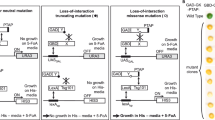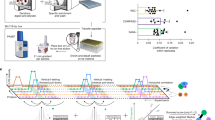Abstract
Protein-protein interactions are often dependent on the post-translational modification of one component of a complex. To facilitate the study of these interactions in signal transduction, we have developed the yeast tribrid system, a modification of the yeast two-hybrid system. We demonstrate that the interactions are dependent upon the presence of a tyrosine kinase, an SH2 domain and a tyrosine containing substrate. Using the gamma subunit of the high-affinity IgE receptor, FcεRI, this approach has been used to isolate a novel SH2-containing family member. The mRNA encoding this novel protein is differentially expressed in rat tissues. The yeast tribrid system can be readily adapted for the characterization of novel tyrosine kinases or substrates, as well as the study of protein-protein interactions which involve other post-translational modifications.
This is a preview of subscription content, access via your institution
Access options
Subscribe to this journal
Receive 12 print issues and online access
$209.00 per year
only $17.42 per issue
Buy this article
- Purchase on Springer Link
- Instant access to full article PDF
Prices may be subject to local taxes which are calculated during checkout
Similar content being viewed by others
References
Cambier, J.C. 1995. New nomenclature for the Reth motif (or ARH1/TAM/ARAM/YXXL). Imm. Tod. 16: 110.
Beaven, M.A. and Metzger, H. 1993. Signal transduction by Fc receptors, the FceRI case. Imm. Tod. 14: 222–226.
Rivera, V.M. and Brugge, J.S. 1995. Clustering of Syk is sufficient to induce tyrosine phosphorylation and release of allergic mediators from rat basophilic leukemia cells. Mol. Cell. Biol. 15: 1582–1590.
Taylor, J.A., Karas, J.L., Ram, M.K., Green, O.M. and Seidel-Dugan, C. 1995. Activation of the high-affinity immunoglobulin E receptor FceRI in RBL-2H3 cells is inhibited by Syk SH2 domains. Mol. Cell. Biol. 15: 4149–4157.
Kolanus, W., Romeo, C. and Seed, B. 1993. T cell activation by clustered tyrosine kinases. Cell 74: 171–183.
Fields, S. and Sternglanz, R. 1994. The two-hybrid system: an assay for protein-protein interactions. Trends Genet. 10: 286–292.
Castellanos, R.M.P. and Mazon, M.J. 1985. Identification of phosphotyrosine in yeast proteins and of a protein tyrosine kinase associated with the plasma membrane. J. Biol. Chem. 260: 8240–8242.
Gartner, A., Nsamyth, K. and Ammerer, G. 1992. Signal transduction in Saccharomyces cerevisiae requires tyrosine and threonine phosphorylation of FUS3 and KSS1. Genes. Dev. 6: 1280–1292.
Lim, M.-Y., Dailey, D., Martin, G.S. and Thorner, J. 1993. Yeast MCK1 protein kinase autophosphorylates at tyrosine and serine but phosphorylates exogenous substrates at serine and threonine. J. Biol. Chem. 268: 21155–21164.
Navon, A., Schwarz, Y., Hazan, B., Kassir, Y. and Nir, U. 1994. Meiosis-dependent tyrosine phosphorylation of a yeast protein related to the mouse p51ferT. Mol. Gen. Gen. 244: 160–167.
Pandey, A., Lazar, D.F., Saltiel, A.R. and Dixit, V.M. 1994. Activation of the Eck receptor protein tyrosine kinase stimulates phosphatidylinositel 3-kinase activity. J. Biol. Chem. 269: 30154–30157.
O'Neill, T.J., Craparo, A. and Gustafson, T.A. 1995. Characterization of an interaction between insulin receptor substrate 1 and the insulin receptor by using the two-hybrid system. Mol. Cell. Biol. 14: 6433–6442.
Gustafson, T.A., He, W., Craparo, A., Schaub, C.D. and O'Neill, T.J. 1995. Phosphotyrosine-dependent interaction of SHC and insulin receptor substrate 1 with the NPEY motif of the insulin receptor via a novel non-SH2 domain. Mol. Cell. Biol. 15: 2500–2508.
Kornbluth, S., Jove, R. and Hanafusa, H. 1987. Characterizaton of avian and viral p60src proteins expressed in yeast. Proc. Natl. Acad. Sci. USA 84: 4455–4459.
Kuster, H., Thompson, H. and Kinet, J.P. 1990. Characterizaton and expression of the gene for the human Fc receptor γ subunit. J. Biol. Chem. 265: 6448–6452.
Law, C., Sidorenko, S., Chadran, K., Draves, K.E., Chan, A.C., Weiss, A. et al. 1994. Molecular cloning of human syk. J. Biol. Chem. 269: 12310–12319.
Paolini, R., Renard, V., Vivier, E., Ochiai, K., Jouvin, M.H., Malissen, B., et al. 1995. Different roles for the Fc epsilon RI gamma chain as a function of the receptor context. J. Exp. Med. 181: 247–255.
Kihara, H. and Siraganian, R.P. 1994. Src homology 2 domains of Syk and Lyn bind to tyrosine-phosphorylated subunits of the high affinity IgE receptor. J. Biol. Chem. 269: 22427–22432.
Shiue, L., Green, J., Karas, J.L., Morgenstern, J.P., Ram, M.K., Taylor, M.K., et al 1995. Interaction of p72syk with the γ and β subunits of the high-affinity receptor for immunoglobulin E FceRI. Mol. Cell. Biol. 15:1: 272–281.
Shiue, L., Zoller, M.J. and Brugge, J.S. 1995. Syk is activated by phosphotyrosine-containing peptides representing the tyrosine-based activation motifs of the high affinity receptor for IgE. J. Biol. Chem. 270: 10498–10502.
Dalrymple, M.A., Mcgeoch, D.J., Davison, A.J. and Preston, C.M. 1985. DNA sequence of the herpes simplex virus type 1 gene whose product is responsible for transcriptional activation of immediate early promoters. Nucl. Acids Res. 13: 7865–7879.
Perlmutter, R.M., Marth, J.D., Lewis, D.B., Peet, R., Ziegler, S.F. and Wilson, C.B. 1988. Structure and expression of Ick transcripts in human lymphoid cells. J. Cell Biochem. 38: 117–126.
Yamanashi, Y., Fukushige, S., Semba, K., Sukegawa, J., Miyajima, N., Matsubara, K., et al 1987. The yes-related cellular gene lyn encodes a possible tyrosine kinase similar to p56lck. Mol. Cell. Biol. 7:1: 237–243.
Pawson, T. 1995. Protein modules and signalling networks. Nature (Lond.) 373: 573–580.
Turner, H., Reif, K., Rivera, J. and Cantrell, D. 1995. Regulation of the adapter molecule Grb2 by the FceRI in the mast cell line RBL2H3. J. Biol. Chem. 270: 9500–9506.
Rose, M.D., Winston, F., and Heiter, P. (1990). Methods in Yeast Genetics: A Laboratory Course Manual. Cold Spring Harbor Laboratory, Cold Spring Harbor, NY.
Guthrie, C. and Fink, G.R. 1991. Guide to yeast genetics and molecular biology. Meth. Enz. 194 1–933.
Schiestl, R.H. and Gietz, R.D. 1989. High efficiency transformation of intact yeast cells using single stranded nucleic acids as a carrier. Curr. Genet. 16: 339–346.
Dalton, S. and Treisman, R. 1992. Characterization of SAP-1 a protein recruited by serum response factor to the c-fos serum response element. Cell 68: 597–612.
Kalderon, D., Roberts, B.L., Richardson, W.D. and Smith, A.E. 1984. A short amino acid sequence able to specify nuclear locaton. Cell 39: 499–509.
Evan, G.I., Lewis, G.K., Ramsay, G. and Bishop, J. M. 1985. Isolation of monoclonal antibodies specific for human c-myc proto-oncogene product. Mol. Cell. Biol. 5: 3610–3616.
Kinet, J.P., Blank, U., Ra, C., White, K., Metzger, H. and Kochan, J. 1988. Isolation and characterization of cDNAs coding for the β subunit of the high-affinity receptor for immunoglobulin E. Proc. Natl. Acad. Sci. USA 85: 6483–6487.
Franzusoff, A., Rothblatt, J. and Schekman, R. 1991. Analysis of polypeptide transit through yeast secretory pathway. Meth. Enz. 194: 662–682.
Pirozzi, G., Terry, R.W., Epstein, D. and Labow, M.A. 1995. Identification and characterization of a novel surface antigen gene induced in mast cells activated through the high affinity IgE receptor. J. Immunol. In press.
Author information
Authors and Affiliations
Corresponding author
Rights and permissions
About this article
Cite this article
Osborne, M., Dalton, S. & Kochan, J. The Yeast Tribrid System—Genetic Detection of trans-phosphorylated ITAM-SH2-Interactions. Nat Biotechnol 13, 1474–1478 (1995). https://doi.org/10.1038/nbt1295-1474
Received:
Accepted:
Issue Date:
DOI: https://doi.org/10.1038/nbt1295-1474
This article is cited by
-
The Lnk Adaptor Protein: A Key Regulator of Normal and Pathological Hematopoiesis
Archivum Immunologiae et Therapiae Experimentalis (2012)
-
A yeast three-hybrid system that reconstitutes mammalian hypoxia inducible factor regulatory machinery
BMC Cell Biology (2008)
-
Adaptor protein APS binds the NH2-terminal autoinhibitory domain of guanine nucleotide exchange factor Vav3 and augments its activity
Oncogene (2002)
-
PSM, a mediator of PDGF-BB-, IGF-I-, and insulin-stimulated mitogenesis
Oncogene (2000)



